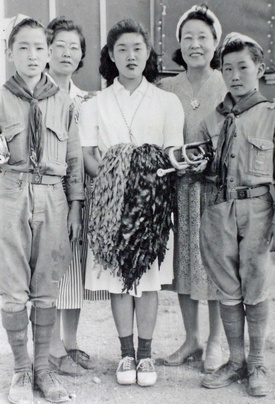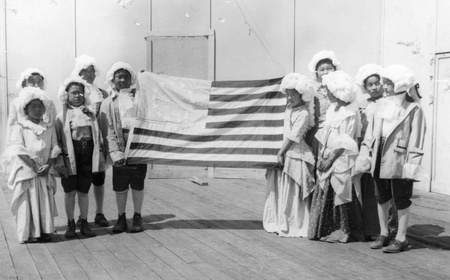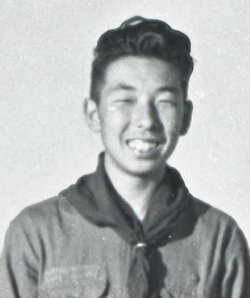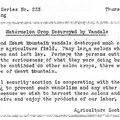BACON, ELEMENTARY SCHOOL STUDENT
We boy scouts went camping at the river and had a lot of good times. But there was one time I will never forget...we saw a patch of watermelons. One boy had a pocketknife, so we plugged melons trying to find some ripe ones. The next day, there was a bulletin put out by the camp newspaper reporting the incident and were we scared.
We had damaged food for our own use. I was really sorry, especially after this notice came out.
Bacon Sakatani interview with JFOs 11/03/04

NOB, HIGH SCHOOL STUDENT
The first group of Scouts went off to Yellowstone on July 8th. There were 100 Scouts from troops 313, 341, and 345. The following Saturday the second group left. Troops 379, 342, 323 and Toru’s troop—333.
On “Y Day” 1944, we climbed aboard the back of a truck with our sleeping bags and a few personal items. I think there were about 30 of us crammed in two trucks. We stood up for the whole trip for three hours, but that was no problem.

Our good cheer got a temporary jolt as we rode through the town of Cody where we heard nasty catcalls from the sidewalk— people shouting racial slurs and obscenities.
But, the days that followed were full of happy and exciting moments.
Our camp was in a CCC (Civilian Conservation Corps) cabin along the Nez Perce Creek. I remember the triangular insects—they were swift and nimble. They’d land on your skin, take a painful bite and fly away before you could react— “deer flies!” There were mosquitoes, too...millions of them. We slept under netting to keep from getting devoured. We still had so many welts, our skin had the texture of a giant football.
Old Faithful, Upper Falls, Lower Falls, Paint Pot, and Morning Glory and all the rest fascinated me. Nowhere else in the world is there an array of geological marvels such as these. There were bears, buffalo, moose, elk and all the other animals that I had never seen before. It may sound unbelievable now, but the Park was deserted. There just weren’t very many people visiting during WWII. This trip was far beyond anything that I could have imagined...definitely the biggest event in my life for a long time. I'll always treasure it. I know others share the same feelings! In fact, the trip was such a success that a lot of boys and girls wanted to sign up for Scouts in hope of getting to go to Yellowstone the next year. But there was not to be another trip to Yellowstone.
Nobuyuki Shimokochi phone interview and emails with JFO 11/12/04
SUTTER, HIGH SCHOOL STUDENT
We all knew Yellowstone was famous for bears. At night we heard them scratching and clawing, trying to get into the compartment where food was stored.
But then, one afternoon we didn’t just hear them...while we were napping, the warning siren came on and we ran outside while to our amazement a black bear strolled into our barrack! We got out of there. But then we realized Sab, our Scoutmaster, was not with us.
Apparently, he did not hear the sirens and was alone in the barrack with the bear.
Then we all burst out laughing when we saw Sab running out of the barracks in his long johns, clutching his boots, and screaming!
Sutter Kajita phone interview with JFO 3/14/05
JAKE, HIGH SCHOOL STUDENT
 Junzo “Jake” Ohara, with his bugle far right, his sister Rei, a pom-pom cheerleader with the Girl Scouts Drill Team and their brother, Tosh. All three were active in scouts. (Courtesy of Bacon Sakatani)
Junzo “Jake” Ohara, with his bugle far right, his sister Rei, a pom-pom cheerleader with the Girl Scouts Drill Team and their brother, Tosh. All three were active in scouts. (Courtesy of Bacon Sakatani)I was proud to be the designated bugler for Troop 379, so every night, when it was time for lights out, it was my job to play Taps. One night, standing alone under the stars I realized how lucky I was to be in this splendid place. My father was still being held in a federal prison with so many of the Issei. I wondered if he could see the same stars in Montana and when or if he would ever come back to us. I had just begun playing, “Day is done…gone the sun” when I realized something large and dark was crawling out from under the barracks. It was a bear! Horrified, I made a dash for the barracks. There were no more Taps that night!
Junzo “Jake” Ohara, phone interview with JFO 5/15/06
M.L. JOHNSON, WYOMING BOY SCOUT EXECUTIVE
Better known as “Johnnie,” Scout executive of the Central Wyoming council, visited the camp after all the scouts had returned from Yellowstone. He also ridiculed reports that the government was taking Japanese Americans on pleasure trips. He told theHeart Mountain Sentinel:
After two years of confinement in a relocation center, Japanese American boys and girls are still as American as apple pie…we were anxious to know what effect their two years behind the fence was having on these youngsters…but no one who would be with them would think for a minute they would be anything but true Americans. They laughed at American jokes, and behaved just like any other American youngster would behave.
Expenses for the trip were covered by the WRA, park officials, and other government agencies. Johnson pointed out that expenses were slight, since the WRA had to feed these youngsters anyway. The only park tours were those for the children, and these were part of the Americanization program—which he called “completely successful.”

SUPERINTENDENT EDMUND B. ROGERS
Rogers became Superintendent of Yellowstone National Park in 1936 and worked with First Lady Eleanor Roosevelt on her programs for the Park Service. In early September, soon after the scouts’ visit, he received many letters of protest from people who lived near the park.
Those who arranged the trip to Yellowstone congratulated themselves and their success, but anti-Japanese feelings outside the camp continued to fester. In early September, Superintendent Rogers reported to the Director of the Department of the Interior that there has been “considerable protest over a projected program of killing elk in the park and distributing the meat to the Japanese Relocation Center.” There was little criticism over killing the elk; the sore point was that the meat would be distributed to Heart Mountain Relocation Center.
Yellowstone Superintendent’s monthly reports, September 1944. Heart Mountain Wyoming Foundation Archives.
*Unforgotten Voices from Heart Mountain is available for purchase through Amazon (Kindle edition) and the JANM Museum Store (paperback).
© 2023 Joanne Oppenheim and Nancy Matsumoto










